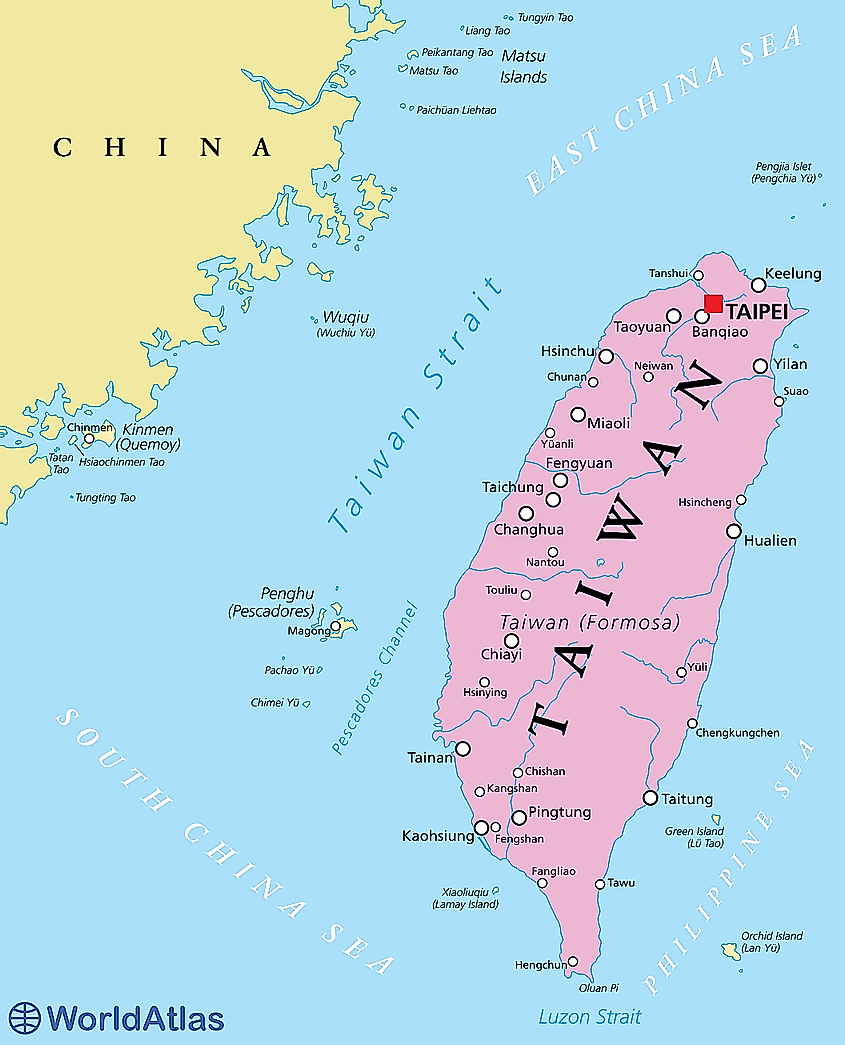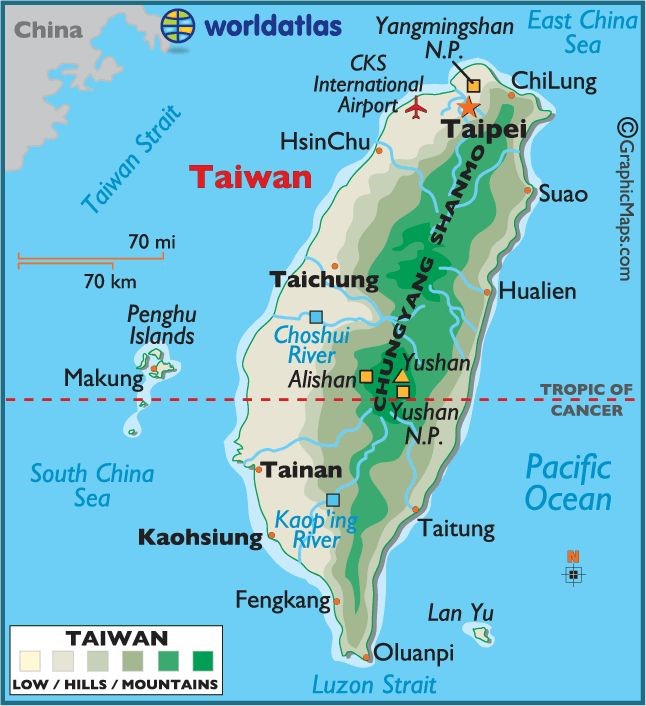Description

Disclaimer: Copyright infringement not intended.
Context
- Seventy-one Chinese military aircraft crossed the sensitive median line of the Taiwan Strait as China began drills around Taiwan.

Taiwan Strait
About
- Also referred to as the Formosa Strait, the Taiwan Strait is a 180-kilometer-wide strait separating the island of Taiwan and continental Asia. It runs between the coast of the Fujian (Fukien) Province and the island of Taiwan.
A strait is a narrow water passage connecting two larger bodies of water, usually two seas.
Part of the South China Sea
Note: The international agreement does not define the Taiwan Strait but places its waters within the South China Sea.
Geographical Features
- The entire strait is on Asia's continental shelf.
- The Taiwan Strait is relatively shallow. It has an average depth of about 490ft.
Rivers draining into it
- Several rivers including the Jiulong and Min rivers from China’s Fujian Province drain into the Taiwan Strait.
Islands on the Taiwan Strait
- Several islands are located in the strait. Kinmen and Matsu are two of the largest and most significant islands in the strait located off the Fujian coast of China.
- The biggest islands along the Taiwan side include Penghu (or Pescadores), Xiamen, and Pingtan.
- The Xiamen and Pingtan Islands are administered by the People’s Republic of China, while the other three islands: Penghu (or Pescadores), Kinmen, and Matsu are under the administration of the Republic of China (Taiwan).
- The Penghu (or Pescadores) Island is the largest and most populous island in the Taiwan Strait.

Significance of Taiwan Strait
Geostrategic location
- Taiwan is located at the concurrence of East China Sea, South China Sea and Philippines Sea.
- It is also located southwest of the Japanese Island Chain and is very close to Okinawa hence has been influenced by Japan significantly.
- For last several centuries, Taiwan has been a strategic island as well as a bone of contention between Japan & various dynasties ruling over China.
- Anyone ruling over the island gets a clear edge over its adversaries.
- In case China rules it, it will have power projection not only in the Pacific but also to Japan, Philippines & other ASEAN countries.
- But if any other country rules it or Taiwan itself is declared as a sovereign nation, the ruler will be able to project itself over China.
Taiwan Strait and trade in the region:
- Taiwan strait is considered one of the busiest shipping lanes in the region with nearly 90% of Chinese, Japanese & Korean trade towards Asia, Middle East and India passes through this strait.
- Since all the major ports of China are located in the yellow sea, its trade has a significant value for China.
- On one hand, China wants to control the trade through Taiwan Strait and on other hand, it wants to safeguard its shipping lanes passing through the strait.
- Since Chinese economy is dependent upon export, China needs control over Taiwan to have an absolute control over this trade route.

Taiwan
- Taiwan is bounded to the north and northeast by the East China Sea, with the Ryukyu Islands(the southernmost part of Japan) to the northeast.
- The Philippine Sea lies to its east, the Luzon Strait directly to its south and the South China Sea to its southwest.
- To the east is found the great expanse of the Pacific Ocean, and to the south is the Bashi Channel, which separates Taiwan from the Philippines. To the west is the Taiwan (Formosa) Strait, which separates Taiwan from the Chinese mainland.
- Taiwan’s climate is subtropical, except for the very southern part of the island, which is tropical.
- Taiwan’s volcanic soil and the frequency of earthquakes on the island indicate a common origin with the other nearby archipelagoes.
Davis Line/ Median Line
- Historically both the People's Republic of China(PRC) and the Republic of China (ROC) on Taiwan espoused a One-China Policy that considered the strait part of the exclusive economic zone of a single "China".
- In practice, a maritime border of control exists along the median line down the strait.
- The median line was defined in 1955 by US Air Force General Benjamin O. Davis Jr.who drew a line down the middle of the strait, the US then pressured both sides into entering into a tacit agreement not to cross the median line.
- The PRC did not cross the median line until 1999; however, following the first encroachment in 1999, Chinese aircraft have encroached over the median line with increasing regularity. The median line is also known as the Davis line.

Taiwan’s Geostrategic, Economic & political significance
Flourishing & Lucrative Taiwanese economy:
- Taiwan has grown significantly in past few decades and has become a 775-billion-dollar economy (As per 2021 data).
- Not only this it has one of the highest per capita GDPs and is the 22ndlargest economy of the world (Although still not recognised as a country) which controls nearly 60-65% of the semiconductor chip business of the world.
- Interestingly, all the countries of the world including China are dependent upon Taiwan for their requirements of Semiconductors.
- Taiwan is also the 5thlargest trading competitor to China and in today’s time when China is facing stiff trade challenges this gap is going to increase in coming future.
- In such scenario, by laying its claim over Taiwan, China wants to kill three birds with one stone. Firstly, it will get a boost in its economy as well as GDP, Secondly, it will also become uncontented leader of Semiconductor Chip market in the world and thirdly or lastly it will absorb one of its biggest competitors in itself.
One China Policy:
- The One China Policy of Strategic ambiguity is also one of the reasons why China wants to lay its hands over Taiwan.
- The policy which was signed or agreed by major economies of the world including United States accept that there is one China on both sides of Taiwan strait and indirectly reaffirms the control of mainland China over Taiwan since the former is not yet recognised as a country.
- So, in the light of this policy, there is no internationally recognised border between China and Taiwan and hence this fact gives a kind of authority to People’s Republic of China (PRC) to carry out military exercises in territorial waters of Taiwan. Concurrently, the one China policy is the biggest tool to facilitate Chinese claim over Taiwan.
Denying military advantage:
- Although United States of America itself follows “One China Policy”, it has supplied Taiwan with large quantities of weapons, Aircrafts and other war machines.
- Since strategically Taiwan is very much important and in the current context where America wants to contain China on international front, Taiwan becomes the matter of utmost importance for both China as well as America.
- In case of China, it becomes the matter of do or die when there is a possibility of Taiwan allowing America or any other major world power establish military bases in its territory. In that case, entire China will be vulnerable so naturally, by claiming its right over Taiwan, China invariably wants to deny any kind of military or strategic advantage to its adversaries.
Navigational Choke Points
- From China’s perspective, Taiwan is one of the critical links in the so-called “first island chain” that includes Japan, the Ryukyus, the Philippines, Malaysia, Indonesia, and Australia.
- Beijing sees the navigational “choke points” between those islands as constraining the People’s Liberation Army’s naval access to the “second island chain” (Guam, the Marianas, the Palau island group and other small islands in the central Pacific) and from there into the open ocean far from China’s shores.
- China’s coastline in the East China Sea lacks the deep-water ports needed to service its naval bases located there.
- Its submarines must operate on the surface until they are able to submerge and dive deep when they reach the area of the Ryukus archipelagoes.
- If China controlled Taiwan, its submarines would have a far easier exit from Taiwan’s deep-water ports into the Pacific.
- They could present a new danger for Japan – which is totally dependent on the East Asia sea-lanes for its energy and other raw materials. Chinese submarines and an enhanced ability to project power into the Pacific could also present an increased threat to the U.S. Seventh Fleet, Guam, Hawaii, and even the West Coast of the United States. Moreover, to the extent China’s far-ranging navy would distract Washington and Tokyo and embolden North Korea’s already-reckless leader, it could directly endanger the security of South Korea.
- From a purely naval and military perspective, control of the island of Taiwan would constitute a huge strategic asset for China and a threat to the region in both Southeast and Northeast Asia.
- Chinese control of Taiwan, its technologically advanced economy, and control of the entrance to the South China Sea it would provide would have major economic, diplomatic, and political implications for the region.
- There would likely be a cascading effect as regional governments recalculate their self-interests in the face of an even more powerfully situated China.
- Singapore might well be intimidated into a more pro-China position, consolidating Beijing’s control of the South China Sea with Taiwan in the north and Singapore in the south.
- Denying China that asset and that leverage is clearly in the strategic security and economic interests of the countries of Southeast Asia, Japan, and the United States.
Closing Remarks
- Taiwan’s Geostrategic, Economic & political significance is immense and the same matters most for not only China but Japan, ASEAN & United States too.
- Over last few years several analysts have been claiming that the South China sea is going to be the most troublesome region of the world in near future and in this case, if we assume a hypothetical situation of war of the worlds, Taiwan will indeed be the trigger point of this war.
INDIA-TAIWAN RELATIONS: https://www.iasgyan.in/daily-current-affairs/india-taiwan-relations
SOUTH-CHINA SEA: https://www.iasgyan.in/daily-current-affairs/south-china-sea
|
PRACTICE QUESTION
Q. Chinese control of Taiwan, its technologically advanced economy, and control of the entrance to the South China Sea would have major economic, diplomatic, and political implications for the region. Comment.
|

https://www.tribuneindia.com/news/world/china-sends-71-aircraft-across-median-line-of-taiwan-strait-launches-drills-495640












